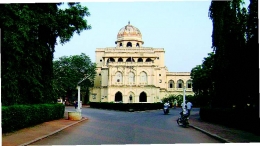While there are any number of reasons why one should not rent and or drive a vehicle in New Delhi, or anywhere in India for that matter, the best reason is safety. Sure, they drive on the left just like folks in Ireland and the UK do, but that is where the similarities end.
Try navigating a toll road, much like the motorways here in Ireland but also sharing the driving lanes with carts pulled by bicycles, camels, donkeys, oxen and the occasional human. Then there are the farm tractors, pedestrians and omnipresent rickshaws that one must be on constant lookout for.
On top of that, even though motorcycles, cars and trucks are supposed to travel in the left-hand lane unless they are overtaking slower moving traffic, the reality is that virtually all of them drive in the middle of the road, straddling both lanes.
Unlike Ireland, the big heavy trucks which carry goods between cities and to stores and factories are not allowed to use many of India’s motorways between 7am and 7pm, in order to ease traffic congestion. But when they are on the road, these big trucks simply take the right of way, regardless of whether or not they are legally entitled to it. The rule is: the bigger the truck, the more right of way its driver believes he is entitled to.
Another curious feature of India’s divided highways is the fact that trucks can apparently enter them at any point and drive against the flow of traffic for distances of several miles until they reach a break in the median strip where they can cross over onto the other side. Imagine my surprise on a trip from Delhi to Agra, when the car I was in had to shift to the left from the inside right-hand speed lane on the highway because a huge truck was barrelling down the road straight at us in that same lane.
Automobile and truck horns constantly assault one’s ears when on the road because India’s drivers not only pay little attention to what is beside or behind them, but also refuse to use their indicators or yield for their fellow motorists, and they frequently change lanes without signalling. Furthermore, Indian drivers make a habit of passing on blind corners, up steep hills or in the face of oncoming traffic, and many of them either don’t use their headlights, or worse, turn on their high beams when they encounter an oncoming vehicle, blinding the other driver. It’s no wonder India has 131.2 fatalities per 10,000 motor vehicles compared to only 1.4 for the UK and 1.8 for Ireland.
However, assuming that one is smart enough to hire a driver to take you to see the many wonderful sights that the country has to offer, one will be truly amazed by many of them. I stayed close to New Delhi for my first two weeks and still didn’t see everything that there was to see in the capital, but I probably could have had it not been for many hours I spent in the United Nations workshop that was the primary purpose for my trip. Having said that, it was also the native Indians who took part in that workshop who served as my guides to what sights I should and eventually did see during my stay.
My first weekend was spent visiting the National Gandhi Museum and the memorial to Mahatma Gandhi on the bank of the Yamuna River in New Delhi. At the memorial site, known as Raj Ghat, there is an eternal fire burning at the spot where Mahatma Gandhi’s mortal body was consigned to flames at his funeral.
The memorial itself is striking for both its beauty and its simplicity, which would also be in keeping with Gandhi’s ideals. It consists of the brick platform on which Gandhi’s body had been laid, and a black marble platform of the same size and dimensions which are surrounded by a white marble fence and several acres of beautifully kept landscaped grounds. Visitors must remove their shoes (10 rupees to check them at at stand near the entrance) so the stone walkways will give you a ‘hot foot’ but fortunately there is plenty of cooler grass to walk on nearby.
The National Gandhi Museum is within easy walking distance of Raj Ghat and is filled with photographs, paintings and sculptures of Gandhi as well as a full-scale replica of his bedroom and ‘office’. The museum also has numerous other artefacts including ‘official’ documents and plaques which were given to Gandhi by leaders from other countries and organisations around the world in recognition of his contributions to India’s history, democracy, non-violence and world peace.
I must say, however, that I am still mystified as regards why Gandhi was never awarded the Nobel Peace Prize. This seems to me to be a striking omission by the Nobel Prize committee, but one that I hope they will someday choose to correct, even if they don’t currently present posthumous awards.
In addition to the numerous historical items which surround visitors within the museum, there are also some very interesting displays outside the building. At the entrance is a large rock carving depicting Gandhi’s ‘Great Salt March’, a non-violent protest against a salt tax which shook the British Empire and led to worldwide recognition of the legitimacy of India’s claims for independence.
Next door to the museum is a full-size replica of Hrid-ayakunj, the residence of Mahatma Gandhi and Kasturba, his beloved who died in his arms while they were both still imprisoned by the British. The residence is surrounded by beautiful gardens including the wonderful gazebo where I had my picture taken under the hands of a huge sculpture of a seated Gandhi.
Next time out I will discuss my visit to Qutab Minar and the Akshardham temple.
Charles Laffiteau is a lifelong US Republican from Dallas, Texas who is currently pursuing a PhD research programme in Environmental Studies at Dublin City University












